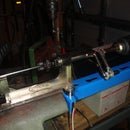Introduction: Electronic Diaper
Long gone are the days of peeking at a diaper to determine if it's that time or not. You know what I'm talking about. Introducing the Electronic Diaper: a high-tech interior garment for infants with a sensor that monitors your child's comfort level. It provides instant audible feedback by way of a buzzer as well as a persistent optical sensory notification system by way of an LED. In theory, it works by making use of a voltage divider which is extremely sensitive to wetness at the tip of the probe. When wet, electricity flows across the leads of the probe but with some resistance. The voltage drop is measured through the microcontroller's analog to digital converter every second. As soon as any voltage is detected, a buzzer goes off like a siren followed by chirps at 5 second intervals for as long as wetness is detected. The LED turns on and stays light indefinitely, however, at the onset of wetness. So after a diaper change, a reset is required.
Step 1: Bill of Materials
Hardware
PC with serial port
PIC burner and dev board w/ POT, DB9 serial (for debugging and development)
Serial cable (for debugging)
PCB making stuff
Single sided Copper clad board (3" x 3")
Paint thinner
Hydrogen Peroxide
Muratic Acid
Plastic tray
Laser printer
Laminator
magazine w/ thin and glossy pages
Components
PIC Microcontroller 16F88
18 pin socket
LED
buzzer
220 Ohm resistor
1 MOhm resistor
4.7 KOhm resistor
0.1 uF catalytic capacitor
on/off switch
2 lead ribbon cable
Software
Digital Diaper software by carlitos (hex and source code)
Eagle Software (if you wish to modify PCB)
JAL compiler (if you wish to modify code)
Tera Term Pro (for debugging)
Miscellaneous
Paper
tape
Permanent marker
Hot glue and gun
Cloth
Scissors
Step 2: Program PIC Microcontroller
Step 3: PCB - Printing
Once printerd, cut out and paste the drawing face down over a copper clad board. To transfer the toner onto the copper clad board, use a laminator. Make a few passes to be sure all the toner is transfered. Immerse the board in water and gently rub off the magazine paper. If not all the toner transfers successfully, you can touch things up using a permanent marker.
Step 4: PCB - Etching
Step 5: PCB - Adding Components
Step 6: PCB - Finishing
Add hot glue over anything (except the PIC) you want to protect.
Step 7: Packaging and Testing
Nothing happened when I turned it on. That's expected. I touched the probe with my tongue and did not get shocked. However, the buzzer immediately went off like a siren followed by the LED turning on. The buzzer would continue to chirp every 5 seconds denoting wetness. I dried the tip of the probe with a paper towel and the buzzer went silent while the LED stayed light.
Step 8: Using the Electronic Diaper
My subject did not cooperate as she refused to have a go with the electronic diaper. Maybe the robot logo scared her. It's hard to say. So, I settled for a simulation. I cut a small slit on the back side of a new diaper and inserted the wetness probe. I poured 2 ounces of water and the electronic diaper worked it's magic. It instantly notified me it's time to change the diaper. Success!
The electronic diaper is not a toy. It has small parts not suitable for human consumption. While all precautions have been taken in lieu of safety, the possibility also exists of electic shock. Ask a certified electronic engineer if the electronic diaper is right for you.
Participated in the
Microcontroller Contest













